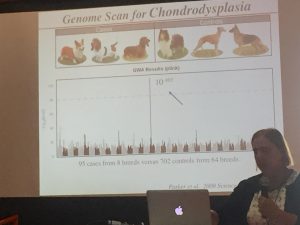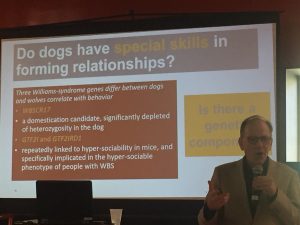CPT and Dog Star Technologies founder and CEO Mark Spivak was an invited speaker during the 2019 International Canine Science Conference held from October 18 – 20 in Phoenix, Arizona. The 3-day Canine Science Conference featured nationally and internationally renowned speakers in the fields of canine genetics, canine anthropology, canine neuroscience, canine behavior, canine training, working dog training, service dog evaluation and training, guide dog evaluation and training, shelter welfare, and canine aging. The conference provided excellent recognition, outstanding networking opportunities, and a wealth of information beneficial in productively evolving CPT’s training methodologies.
Mark’s presentation was entitled, “What We’ve Learned: Practical Applications for Researchers, Trainers, and Pet Owners from Recent Awake fMRI Studies.” The abstract was:
Research becomes more cogent when study conclusions readily segue to practical applications. The awake fMRI process developed by Greg Berns and Mark Spivak has provided a unique opportunity to not only better understand the bidirectional relationship between canine brain activity and behavior, but to improve processes for academic researchers and professional trainers and behaviorists. In addition, on a potentially much larger basis, advanced canine neuroscience knowledge enables significant avenues for improving the pet owning experiences for dog owners who do not possess professional credentials. As the owner of a pet training company that has educated over 50,000 dogs and dog owners, Mark Spivak will discuss practical implementations of the team’s fMRI experiments that have improved outcomes for pet dogs and pet owners. In particular, Mark will discuss advancements regarding pet lifestyle management, human-dog communication, reward selection, impulse control training, behavior modification protocols, and service dog evaluations that occurred as a result of the team’s research findings.
Mark’s talk was very well received. The conference featured a total of 46 presenters from a total of 8 countries, including, the United States, Canada, Germany, Austria, Sweden, Russia, Australia, and Singapore. In addition, non-presenting attendees arrived from the UK, France, and Switzerland.
Speakers and subjects included:
• Evan L. MacLean, University of Arizona- “Ontogeny & Heritability of Cognitive and Temperamental Traits in a Pedigreed Working Dog Population”

• Michael B. Hennessy, Wright State University- “Social Buffering of Stress Responses in the Animal Shelter”
• Elaine Ostrander, National Human Genome Research Institute, National Institutes of Health- “Genetics of Morphology in Dog Breeds”
• Sarah Marshall-Pescini, University of Veterinary Medicine, Vienna & Wolf Science Centre- “What Made Dogs Dogs? Assessing Different Domestication Hypotheses in Light of Results Comparing Similarly Raised & Kept Wolves & Dogs”
• Clive D. L. Wynne, Arizona State University- “Why Dogs Love Us”
• Gregory S. Berns, Emory University- “Eight Years & One-Hundred MRI-Dogs: Awake Unrestrained fMRI in Dogs Reveals Common Neurobiology with Human Health & Disease”
• Madeline H. Pelgrim, University of Toronto- “What’s the Point? Domestic Dogs’ Understanding of the Accuracy of Human Social Cues”

• Robert W. Mitchell, Eastern Kentucky University- “Why Talk to Dogs During Play? An Assessment of the Usefulness of Commands”
• Erin Chrysafis, California State University, Fresno- “Assessing Human Attention as a Reinforcer for Dog Behavior: A Methodological Comparison”
• Heidi Lyn, University of South Alabama- “All Points are Not Created Equal”
• Julian L. Mendel, Florida International University: International Forensic Research Institute- “”Agri-Dogs”: Scent Discriminating Canines for the Detection of Plant Diseases”
• Sarah Krichbaum, Auburn University- “Exploring Working Memory Capacity in Detection Dogs”

• Glen J. Golden, Colorado State University- “Training the Domestic Dog to Discriminate Odors Associated with Wildlife Disease”
• Kristen Cunningham, University of Nebraska Omaha- “Effects of Oxytocin on Therapy Dogs’ Behavior and Physiology”
• Christina Hansen Wheat, Stockholm University- “Dogs, but Not Wolves, Lose Their Sensitivity Towards Novelty with Age”
• Joshua Van Bourg, Arizona State University- “Prosocial Rescue Behavior in Pet Dogs”
• Lynna C. Feng, Guide Dogs for the Blind- “Puppy Behavior Associated with Success in a Guide Dog Program”
• Lucia Lazarowski, Auburn University- “The Development of Problem-Solving Abilities in a Population of Candidate Detection Dogs”
• Jennifer L. Essler, School of Veterinary Medicine, University of Pennsylvania- “What Can Working Dogs’ Performance on the Detour Task Tell Us About Their Future Career Placement?”
• Rachel J. Gilchrist, Arizona State University- “Using the C-BARQ to Predict In-Home Behaviors of Adopted Dogs”
• Janis L. Bradley, National Canine Research Council- “What is the Evidence for Reliability & Validity of Behavior Evaluations for Shelter Dogs? A Prequel to ‘No Better than Flipping a Coin’”
• Erica N. Feuerbacher, Virginia Tech- “Can an In-Shelter Behavior Test Predict Post-Adoption Separation-Related Problem Behavior?”
• Liam Clay, University of Queensland, Gatton- “In Defence of Canine Behaviour Assessments in Shelters: Outlining Their Positive Applications”
• Courtney L. Sexton, The George Washington University- “Face to Face: Impacts of Expressive Communication & Domestication on Eye Muscle Morphology in Canids”
• Samantha L. Bissell, University of Nebraska Omaha- “Cascading Effects of Early Life Stress: An Integrative Dog Model of the Hypomethylation of the Glucocorticoid Receptor (NR3C1)”
• Lidia Boghean, University of Nebraska Omaha- “Early Life Stress & DNA Methylation of the Oxytocin Receptor Gene (OXTR) Predict Dog Change in Cortisol & Affiliative Behavior During an Attachment Paradigm”
• Ana G. Jimenez, Colgate University- “Effects of Changes in Lipid Membrane Composition in Primary Dermal Fibroblasts from Small & Large Breed Dogs on
Aerobic Cellular Metabolism & Oxidative Stress”
• Shanis Barnard, Purdue University- “Development of a New Protocol for Welfare Evaluation of Dogs Kept in Commercial Breeding Kennels”
• Jennifer L. Abrams, Animal Care Centers of NYC & Hunter College, City University of New York- “The Use of Trazodone Hydrochloride to Reduce Stress in Dogs During the Transition Period into a Municipal Animal Shelter: Impact on Incidence of Illness, Length of Stay, & Outcome”
• Lisa M. Gunter, Arizona State University- “Investigating the Effects of a Short-Term Outing Program on Shelter Dog Welfare”
• Hannah E. Flint, Purdue University- “Establishing a Behavioral Time Budget for Dogs in Commercial Breeding Kennels to Enhance Welfare Assessment”
• Stasha Arifin Wong, National University of Singapore & SOSD- “Welfare Dilemmas in Stray Trap-Neuter-Release-Management Policy”
• Christoph Jung, Petwatch- “How Old are Dog Breeds?”
• Martha Hoffman, University of Rochester & College of Veterinary Medicine, Cornell University- “Leveraging Privately Curated Pedigree Databases to Study Population Genetics & Demography in Dogs”
• Kelsea M. Brown, National Canine Research Council- “Is Canine Sociability a Heritable Trait? Retired Racing Greyhounds Shed Insight”
• Daniela Pörtl, Saale-Unstrut Klinikum Teaching Hospital Leipzig & Jena Universities- “Is Dog Domestication an Epigenetic Disclosure?”
• Gitanjali E. Gnanadesikan, University of Arizona- “Estimating the Heritability of Cognitive Traits Across Dog Breeds Reveals a Heritable Cooperative-Communicative Factor”
• Julie C. LaBagnara, University of Massachusetts Boston- “It’s the Pits: Racism & the American Pit Bull Terrier”
• Nicole J. Passmore, Hunter College, City University of New York- “Unique New York: Examining the Impact of Phenotypic Variations, Breed Labels & Geographic Location on Length of Stay in a No-Kill Shelter in New York City”
• Alexandra Protopopova, The University of British Columbia- “Establishing Best Practices of Displaying Dogs at Adoption Events: Effects of Containment, Cost, & Volunteers on Adopter Behavior”
• Valeri Farmer-Dougan, Illinois State University- “Foster Parent Training: Does Behavior Consultation & Behavior Training Improve Foster Parent Retainment”
• Ashley Prichard, Emory University & Georgia Tech- “2D or Not 2D? How the Dog Brain Processes Dimensional Objects”
• Sarah-Elizabeth Byosiere, Hunter College, City University of New York- “Visual Perception in Dogs (Canis lupus familiaris): Are Dogs Susceptible to Visual Illusions?”
• Sarah Lozano, Illinois State University- “Dogs in the Grey Zone: Canine Perception for Going Over or Under a Barrier”
• Olga V. Sibiryakova, Lomonosov Moscow State University- “High-frequency Sonic Vocalization in Domestic Dogs: Polyphony & Effect of Body Size on the Acoustics”